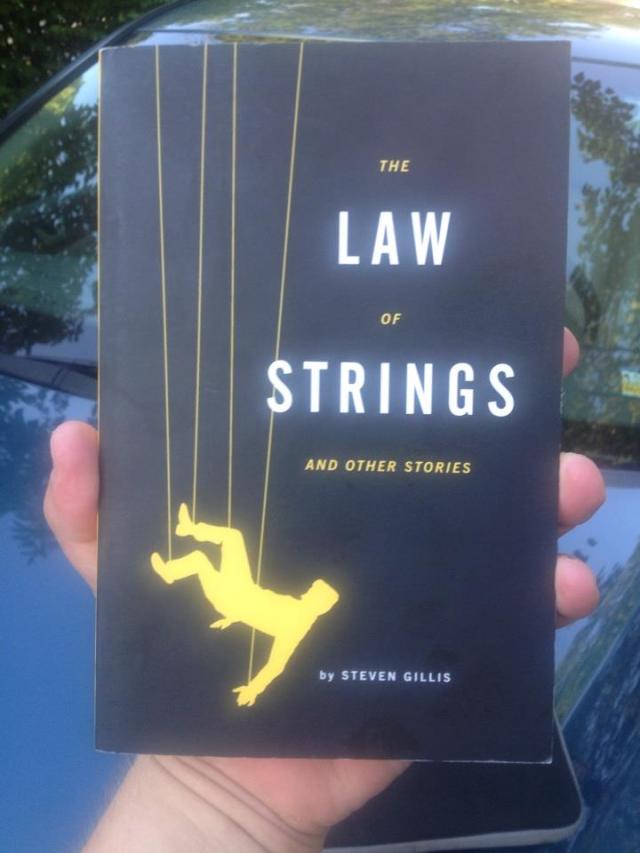Hello, Story366! Back at you for Short Story Month after taking the weekend off. Got a lot of yard work done, ate some good meals, saw Guardians of the Galaxy Vol. 2, watched the Cubs, including that eighteen-innning marathon last night (none of this Cubs business turned out well, by the way), and generally avoided grading before the big dump that’s coming this week. So, no short story blogging, and because this isn’t 2016, I’m quite okay with that. Heck, if I don’t get this done and posted by midnight, I won’t even hate myself (Note: It’s the next morning and me and I are on relatively good terms).
Today, I read from Steven Gillis‘ most recent story collection, The Law of Strings, from Atticus Books. I should reveal here that Steve and I have a pretty intimate relationship, in that Steve is one of the co-founders of Dzanc Books, where my first collection, Elephants in Our Bedroom, appeared back in 2009. On top of being one of the gents (along with Dan Wickett, a statue of whom I have in my back yard, fountain-style) who launched my career, he also personally edited the manuscript, making me kill my darlings, axe my babies, harpoon my pets, and poison my beloved. He made me a better writer, left me with a better book. So, FYI, as you read this glowing review.
I realized it kind of sucks for me, in that light, to not have read this book before, but hey, that’s all fixed now, right? Right. I sat on my front porch, tried to catch my newly planted flowers in the act of growing, and really dove in, trying to get a good handle on what it is that Gillis does with the form. From what I can tell, Gillis is an ephemeral storyteller, not afraid to experiment with ideas, as well as voice, narration, and structure, and to make references to smart people-type things like physics and philosophy. On top of all that, the stories I read were all very matter-of-factly told, almost metafictionally, as if the narrators knew they were telling stories, or at least that they were trying to explain something about their characters, something much more deliberate than an average narrator. I liked being told so much as I read, the effect that this stylistic choice induced, as if Gillis were trying to take a step back, remove the narrator from the action as much as possible, but still maintain authority. Overall, this choice makes Gillis’ stories sound unique, giving Gillis his own brand, his own style. In that way, this collection is both tight and unique.
In choosing a story to write about, I’m heading to my default, the title story, “The Law of Strings,” quite a solid piece of fiction. “The Law of Strings” is about Lange, a physics grad student who is dating/lives with another physics grad student, Eva. The story opens with Lange observing Eva, who is sleeping in their bed, tied down with string, why we’re not told. Next scene, we back up to a couple of nights, when the pair are at a party and Eva is being courted by a man named Jayson, a courting that’s going quite successfully. Eva is clearly intrigued with Jayson, first chatty then handsy, and Lange knows it—and Eva knows he knows it. On their way home, their relationship fluxing in dire straits, Eva makes a suggestion, the one that leads to us to that opening scene, her tied to their bed with string.
More or less, this is Eva’s plan: If Lange wants to keep her around, and she wants to stay, she’d better tie herself down, make it impossible for her to leave, as wandering bodies will wander if not tethered by some force. Once Eva’s properly secured, Lange watches her sleep—he’s not allowed on the bed with her—contemplating exactly what his course of action is. All of this tying up is Eva’s idea, but, you know, it’s resoundingly odd and Lange knows it—what’s Eva playing at. This is where that distant narration comes in handy, us believing all of this because it’s coming from this really exacting, neutral perspective.
The story is more than Eva tied to the bed, as eventually, logistics take over: Eva has to eat and go to the bathroom. Then, Lange and Eva’s weekend takes turns, some logical, some unpredictable, leading up to a satisfying denouement, which I won’t discuss here. However, that’s just the plot, leaving much to be said about Gillis’ approach, his themes, and how the story reads. A lot of this has to do with physics somehow, or at least that’s how Gillis plays it, basic theories that I didn’t understand in high school or college, and don’t fully understand here. Lange and Eva are physicists, remember, so Lange incites a lot of physicists—to name one, in the first paragraph, there’s reference to a book by Jerzy Kowalsky-Glikman, who, according Wikipedia, is indeed a physicist—and without reading a whole lot of stuff I still wouldn’t understand, I’ll just concede that it’s important. But it’s not only physics at work here, as there’s just as much psychology, if not more, making the story so interesting, not to mention disturbing.
Steven Gillis is a publisher, editor, and author, and he does all of them rather well. I’m glad I got to read from The Law of Strings today, that I got to know these stories, to see what Steve does, time after time, in this form. These are challenging but rewarding stories, but they’re also weird and funny. I enjoyed this book a lot.






